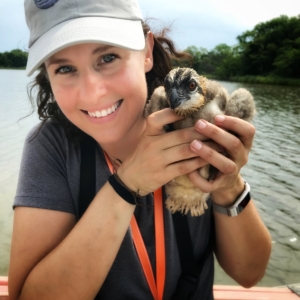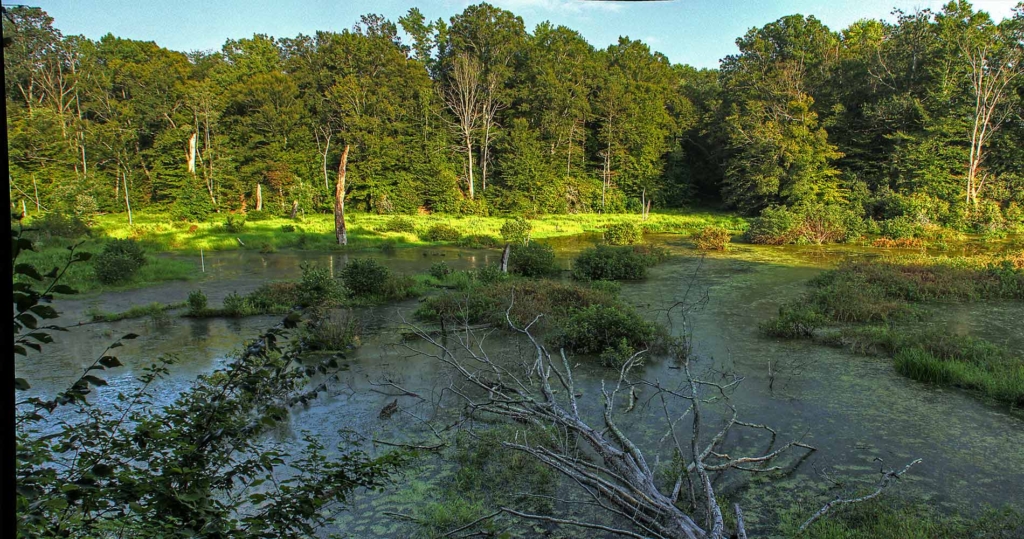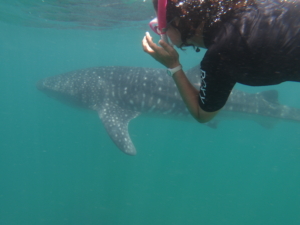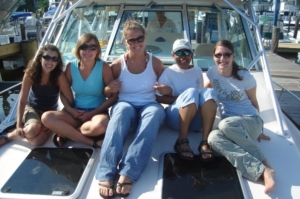CRC Alumni: Where are they now? – Liana Vitali
CRC’s Environmental Management Career Development Program works with the Chesapeake Bay Program partnership to offer three-year staff opportunities for science, management, and policy graduates as the partnership works to protect and restore the Chesapeake Bay. After managing the program for 30+ years, we have developed quite the extensive collection of alumni. We look forward to developing an organized alumni network and to sharing their stories with you!
To kick things off, we are thrilled to introduce you to Liana Vitali who is the Citizen Science and Stewardship Coordinator at Jug Bay Wetlands Sanctuary. Liana was a staffer (or fellow as they were called at the time) from 2007-2009. During her tenure in the program, she supported the Bay Program’s Living Resources Subcommittee which eventually evolved into today’s Sustainable Fisheries and Vital Habitats Goal Implementation Teams.
CRC: Welcome, Liana! We are excited to have this opportunity to catch up, reflect on your time with CRC, and share the incredible work that you have been doing since your time in the program. Let’s start by talking about your work with the Living Resources Subcommittee. Would you share some of your accomplishments with us?

Liana holding a newly banded Patuxent River osprey chick.
Liana: I would love to share two accomplishments I am most proud of; one professional and one personal. Way back in the day when we used to have subcommittees, I had the pleasure of supporting working groups dedicated to the management of five key living resources: blue crabs, shad, menhaden, oyster, and striped bass. I joined the subcommittee at a pivotal time as partners were debating the introduction of the non-native oyster (Crassostrea ariakensis) to the Chesapeake Bay. I learned so much about artful environmental politicking from Mike Fritz, Living Resources Coordinator at CBP and a mentor of mine at the time. The decision was made during my tenure to not introduce the nonnative oyster into the Bay; a decision that both Mike and I were proud to have played a role (though admittedly my role was much smaller!)
As a fellow, I found myself at the intersection of entry-level professional and quarter-life crisis. I often felt hazy on what my next professional steps should be or really what any of the steps were to get to what I considered my dream job – working outside, studying and immersed in nature both locally and globally, as often as possible. Recognizing how pitifully little I knew about how the world worked, I figured the Chesapeake Bay Program complex was full of professionals who somewhere along the way, found themselves into a career they considered fulfilling. With Melissa’s help, I organized brown bag mentorship lunches for the fellows and we invited CBP mentors to join us and share their career journey with the hope that their lessons will demystify our own professional futures. We learned quite a bit from each of our speakers but one of the pieces of advice that stuck with me for over ten years now came from Mr. Mike Fritz himself. He said, “work expands to fill the time allowed.” I pondered this for days, even weeks after he said it and realized it was one of the most truthful statements I ever heard. I had become complacent in my young professional life. It was easy to punch the clock in the morning and evening, go home to make dinner, head to bed, and do it all again. If I wanted to figure out my path, I needed to actually walk it. Self-imposed deadlines started becoming my path and sure enough, the fog lifted. A few months after Mike’s talk, I accepted a job as the Program Coordinator for Wildscreen (USA) launching me into five years of international wildlife and conservation education program development.
CRC: What a great life lesson! Tell us more about your time with Wildscreen and how you transitioned from your position there to Jug Bay Wetlands Sanctuary?
Liana: Working for Wildscreen was extremely challenging and rewarding in ways I could not have anticipated. My experience balancing the opinions and needs of seemingly endless Chesapeake Bay watershed partners on any living resource issue served me well at Wildscreen. Our primary partners and organization headquarters were in Bristol, England. Our secondary partners, however, came from a myriad of global conservation organizations. Wildscreen was and is dedicated to empowering wildlife conservation through the world’s best emotive and impactful films and photographs. Our partners included National Geographic, Discovery, Animal Planet, Disney, Jane Goodall Institute, Conservation International, The Nature Conservancy and more. Our patrons were Sir David Attenborough, Sylvia Earle, and HRH Prince Phillip who hosted an annual fundraising lunch for us at Buckingham Palace. Working at Wildscreen was like a nose-dive into high-level global conservation work, often with big egos. Taking these challenges in stride, our team was able to create many educational programs that I am still so proud to have been a part of. One standout program was a multi-partner effort in Chicago to link south shore students from the Bouchet Academy (Michelle Obama’s elementary school) with Jane Goodall Roots & Shoots mentors and Lincoln Park Zoo staff to create digital scavenger hunts around the zoo for anyone to play. Our program gave children a creative outlet and a safe, after-school environment to express themselves artistically.
My Wildscreen journey culminated in 2015. Because our team was so small and our CEO was transitioning to a new opportunity outside of Wildscreen, I was the acting CEO for six months that year. I quickly realized our Board was seeking to install me as the permanent CEO. While it would have been an amazing opportunity, I still heard whispers of my dream job – working outside, studying and immersed in nature both locally and globally, as often as possible. On a random job search one day, I came upon an announcement for a Naturalist position at Jug Bay Wetlands Sanctuary in southern Anne Arundel County, Maryland, my home county. The job was seeking someone to be the Education Coordinator in charge of field trips and public programs. The work involved long days outdoors in any and all weather conditions including some field research. I was hooked. I applied, interviewed twice, and laid everything I had on the table. A few days later, I was offered the job (at a pay cut) and I enthusiastically accepted. While the job offered me a bit less than my current salary at the time, the sacrifice has repaid itself tenfold in quality of life over the last five years.

Jug Bay Wetlands Sanctuary
Photo Credit: Jug Bay Wetlands Sanctuary
CRC: At Jug Bay, you are responsible for coordinating stewardship projects and citizen science on the sanctuary’s wetlands. Tell us more about your work.
Liana: I still pinch myself each day that I arrive at work at a literal Sanctuary! There is never a “same old boring routine” when you are in charge of the stewardship and citizen science efforts at a beautiful 1700-acre nature preserve in the Maryland coastal floodplain. While I began my time at Jug Bay as the Education Coordinator and loved my work in that role, I am thrilled to now be in charge of everything from tree plantings and river clean ups, to box turtle telemetry and mist-netting. It is also literally part of my job to paddleboard the river looking for river otters (what?!).
As with any job, it’s not always sunshine and roses at the Sanctuary. We have an extremely small staff that makes tackling important environmental management issues difficult. One minute I’m digging up pampas grass in the meadows, the next I’m learning just enough code to launch a new website to replace our old one, defunct now for two years. Though I hold an undergrad degree in Biology and Ecology and a graduate degree in Zoology, I have never been a practical scientist. I’ve educated others for years towards careers in science but I myself have never actually been one until now. There are days the imposter syndrome absolutely flares. Sometimes, though, I learned I just need to take a breath, maybe a small step back to ground myself better and remind myself of my strength and capabilities, regroup and move forward again. And so I do. I’ve learned the hard way that life is a practice, not a perfection. And each day I return home with dirt under my fingernails and wild hair under my hat, I know I am imperfectly enough.
CRC: What is your favorite thing about working at Jug Bay Wetlands Sanctuary?
Liana: My favorite current project is our efforts to create a sister sanctuary partnership between Jug Bay Wetlands Sanctuary and Palo Verde National Park, Costa Rica. We began exploring a potential partnership with Palo Verde in March 2019 when we visited the park for six days. Supported by the county and the Friends of Jug Bay, our affiliated nonprofit, ten county staff members and Friends members joined Palo Verde staff in meaningful exchanges of ideas, hopes, dreams, and future possibilities. We returned from that trip filled with positivity and the county agreed that a partnership was worthwhile. The Friends have created a return trip to Costa Rica this coming March 2020 and I will be a volunteer trip leader leading 15 participants on our own six-day excursion that will raise enough money to bring four Palo Verde staff members to Jug Bay in August 2020.

A glimpse of daily life as a whale shark citizen scientist in Baja.
While working at Wildscreen, I earned my Masters in Zoology through the Miami University of Ohio Global Field Program. Joining this program was one of the best decisions I have ever made in my life. This predominantly online program is perfect for working professionals seeking to earn their Masters and also includes a study abroad component each summer for three years. As a student in the program, I studied land and aquatic field methods, community-based conservation, and science inquiry in Baja, Mongolia, and Thailand. After graduating, the program field director asked me to join the staff as an adjunct faculty member. Since 2014, I have taught courses in Baja and Belize. Working more deeply with the in-country partner in Baja, I founded a whale shark citizen science program in 2015 that brings participants to the Sea of Cortez to study whale shark populations each August. Since 2015, I coordinated over a dozen week-long journeys to Baja and led several myself. Leading students and/or participants on immersive, international journeys has become heart work for me bringing an intense personal fulfillment. I am beyond excited for Costa Rica in March and wherever this work brings me in the future.
CRC: That is incredible! Sign us up for your next international adventure. How do you think your time spent with CRC and the Chesapeake Bay Program helped prepare you to continue moving forward in your career?
Liana: CRC and the Chesapeake Bay Program gave me my first professional opportunity in the environmental field. I am certain that this experience and the supportive mentors I discovered as a fellow are the reasons I am where I am today and for that I am grateful. I know the meetings in the Fish Shack can seem unbearably long and cube life can be admittedly soul-crushing at times, but it’s what you make of that life within and outside of that cube that counts. There are countless resources available in and around the Bay Program complex and I feel the connections I made with my fellow fellows at the time were some of the most important outcomes of the experience. We were a close-knit group in the late 2000’s, often hitting up Moe’s on Monday for $5 burrito meals (do they still have that?), Friday night happy hours, hilarious summer camping trips, and more. We became a family and leaned on each other for support and encouragement. CRC taught me the value of a “work family” and it’s something I have sought in every job since.

A throwback photo with some of my fellow fellows on a CRC boat outing to study oyster reefs and water quality on the Severn River.
CRC: Do you have any advice for our current and future Staffers as they spend time with us in the Environmental Management Career Development Program and prepare to take the next steps in their own careers?
Liana: I spent a lot of time during my CRC tenure tying myself to what I thought my life should be or should have been by the time I was 25 and precious little time appreciating and accepting that who I was and where I was was absolutely enough. My best piece of advice at this moment is to practice releasing yourself from expectations and create space for yourself to grow into the life you want and deserve. And if you ever find your work expanding to fill the time allowed, make a plan, lower your head, make your path, and go.
CRC: Thank you, Liana for sharing your journey and wisdom with us. We look forward to staying in touch and seeing where your path leads you over the years to come.
For additional information regarding CRC’s Environmental Management Career Development Program, please contact Melissa Fagan, Environmental Management Career Development Program Coordinator at faganm@chesapeake.org. Funding for CRC’s Environmental Management Career Development Program is provided through a cooperative agreement with the US EPA.
